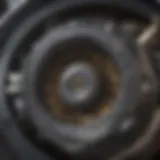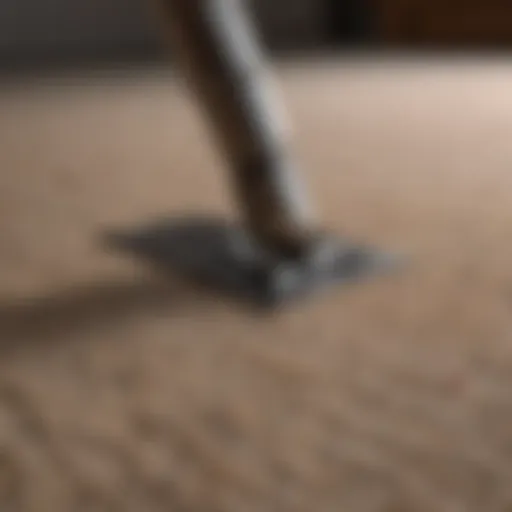Exploring Masking Tape's Benefits in Concrete Projects
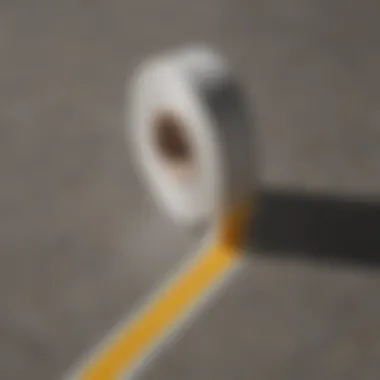

Overview of Topic
When it comes to home improvement, concrete projects are a popular choice for many homeowners. From driveways to patios, concrete provides durability and style. However, one often overlooked hero of concrete work is masking tape. This simple tool plays a crucial role in ensuring clean lines and preventing messy finishes. In this section, we'll explore why masking tape is essential in concrete applications and how it can dramatically affect the outcome of your projects.
Importance of the Topic
The significance of masking tape in the concrete world cannot be understated. Not only does it help in achieving professional-looking results, but it also saves time and minimizes waste. For instance, knowing how to use masking tape effectively can prevent the dreaded splatter of paint or sealant on unwanted areas, which might call for additional touch-ups. This is particularly important when working with colors, as any slip-ups can be glaringly obvious. By mastering the use of masking tape, you’re setting the stage for success.
Common Challenges and Solutions
While masking tape is a straightforward tool, several challenges can arise during its application. Let's take a look at some common issues homeowners face along with practical solutions.
- Adhesion Problems: Many people notice that the tape doesn't stick well to the surface. This is often because of dust or moisture on the concrete.
- Bleeding Underneath the Tape: This often occurs when using paint or sealants that seep under the tape, creating an unwanted mess.
- Solution: Clean the surface before application. A quick wipe with isopropyl alcohol can enhance adhesion significantly.
- Solution: Use a specific type of masking tape designed for smooth surfaces. Additionally, sealing the edges of the tape with a thin layer of the same material you’re applying can also help.
"A little preparation goes a long way; taking time to prep ensures your finish is top-notch."
Product Recommendations
In the realm of concrete projects, not all masking tapes are created equal. Here are some leading names that excel in performance:
- 3M Blue Painter's Tape
This tape is especially popular for its ability to stick well and remove cleanly. It's perfect for giving you those crisp lines without tearing when removed. - FrogTape
Known for its unique Paint Block Technology, FrogTape seals the edges of paint to prevent bleed. - Scotch Heavy Duty Masking Tape
This tape has a strong hold and is great for larger projects. It works well even in damp or humid conditions.
- Benefits: Good adhesion, easy removal, and it won't damage your concrete surface.
- Benefits: Provides a barrier against paint, ensuring that the lines remain sharp and clear.
- Benefits: Reliable performance in various conditions, making it a versatile choice.
Step-by-Step Guides
Let’s break down the process of using masking tape in your concrete projects to ensure that you achieve the best possible results.
- Preparation
Before applying the tape, inspect the area for any debris or moisture. Clean the surface thoroughly as mentioned earlier. - Applying Masking Tape
- Sealing the Edges
If you're using a product that could bleed under the tape, take a brush and apply a thin layer of the same product over the tape edges to seal it. This adds an extra layer of protection against seepage. - Proceed with Your Project
Now that the tape is securely in place, continue with your painting, sealing, or any other application. - Removing the Tape
Once your material has dried, carefully peel the tape away at a 45-degree angle. This will help prevent any flaking or tearing of the applied surface.
- Start at one edge of the area.
- Lay the tape down flat, making sure to press it firmly against the surface to avoid air bubbles.
- Extend the tape along the line, ensuring it's straight.
By following these steps and choosing the right products, you can transform your concrete projects from mundane to marvelous.
Foreword to Masking Tape in Concrete Work
When it comes to concrete projects, the simplest tools can make the biggest impact. Masking tape might not be the first item that springs to mind when one thinks about concrete work, but it certainly deserves a spotlight. This section delves into how masking tape is more than just a roll of sticky goodness; it serves multiple crucial functions that are often overlooked.
One of the primary benefits of masking tape is its role in achieving clean lines. For folks involved in decorative concrete, whether it’s a homeowner attempting a DIY project or professionals in the field, clean edges can drastically enhance aesthetics. No one wants to see paint bleed into the wrong area or have rough, jagged lines marring a polished surface. With proper application, masking tape can act as a reliable barrier, ensuring that colors remain defined and edges sharp.
Moreover, it also plays a petrochemical role in protecting surrounding surfaces from drips, spills, and errant splashes during various stages of application, from painting to sealing.
Let's dive deeper into the world of masking tape, starting with a clear understanding of what it really is.
Defining Masking Tape
Masking tape is a pressure-sensitive adhesive tape made primarily from long, thin strips of paper or plastic coated with an adhesive that bonds easily to a variety of surfaces. Unlike duct tape, which is often too thick for cleaner lines, or painter's tape, which may not hold up as well in outdoor conditions, masking tape strikes a balance. It's designed to be easily removable without leaving a nasty residue behind. Its colors vary, but it’s most commonly found in a beige or tan, which blends nicely with many surfaces yet still provides a distinct visual cue.
Historical Context of Use
Historically, the use of masking tape has evolved significantly since its introduction. It first came to light during the early decades of the 20th century, originally as a solution for painters wanting cleaner finish lines. Back then, its primary use was limited to indoor applications and simple projects.
Fast forward several decades, and the construction and remodeling industries have embraced this handy tool for much more than mere painting. Applications have broadened to include crafting, automotive projects, and obviously, concrete work.
The introduction of different types and strengths of masking tape has further solidified its place in concrete construction. Specialty types developed for outdoor use or specific purposes have evolved as the needs of builders and DIY enthusiasts have expanded. Masking tape's versatility is now undeniable, showcasing its role in both simple home projects and large-scale construction endeavors.
"In the world of construction, the tools we overlook often hold the keys to a successful finish. Masking tape is one of those tools."
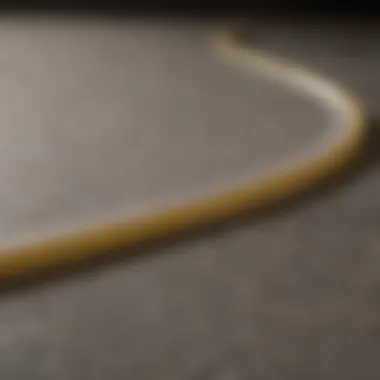

In summary, understanding masking tape’s definitions and historical context reveals its significant place in concrete jobs. Its function in ensuring clean applications and protecting surfaces demonstrates that although small, it's a mighty contributor to the overall success of concrete work.
Types of Masking Tape for Concrete
In concrete work, the type of masking tape used can make or break a project. The right tape ensures cleaner lines, improves adhesion, and makes the entire process smoother. Let’s explore what sets different types of masking tapes apart, and how choosing the right one can elevate your concrete project to new heights.
General Masking Tape
General masking tape serves as the basic option for covering surfaces that need protection from paint or other materials. While this tape can handle some projects, it might not always hold up against moisture or extreme temperature changes.
One common scenario where general masking tape falls short is in areas with high humidity. For example, using standard tape to mask edges on a rainy day could result in the tape losing grip, leading to rough edges when the paint or coating is applied. Generally, this kind of tape is easy to find and economical; however, if you're diving into a more ambitious concrete task, it might not be the best choice.
Specialty Masking Tapes
Specialty masking tapes bring a variety of much-needed characteristics tailored to specific conditions. They are designed to address the unique challenges that come with concrete work, providing benefits that general masking tape simply cannot match.
Waterproof Masking Tape
Waterproof masking tape is a game-changer when it comes to projects exposed to moisture. This type of tape is specifically designed to resist water from rain or spills, ensuring that crucial details don’t get messed up. A key characteristic of waterproof tape is its durable adhesive that sticks firmly even in wet conditions.
The unique feature that sets waterproof masking tape apart is its ability to keep edge lines sharp. This allows for precise finishing on concrete surfaces. A notable advantage is that it significantly reduces the risk of paint bleeding through, which can be a hassle to correct later on.
However, a disadvantage of waterproof masking tape may be its higher cost compared to general options. But if you're aiming for perfection in your concrete projects, the investment is worth it.
High-Temperature Masking Tape
High-temperature masking tape is specifically made to endure extreme heat without losing its adhesive properties. This is particularly beneficial when working on projects that involve curing concrete in warm conditions. The key characteristic of high-temperature tape is its ability to resist not just heat but also chemical exposure.
This tape’s unique feature lies in its versatility; it can be used in various temperatures. It provides the assurance that your tape will stay intact during curing or other high-heat applications.
The advantage of using high-temperature masking tape is that it prevents the tape from lifting during the curing process, ensuring clean lines and accuracy in your work. However, it often comes with a higher price tag, which might pose a challenge for budget-conscious homeowners.
Eco-Friendly Options
With growing environmental concerns, more manufacturers are now offering eco-friendly masking tapes. These tapes are typically made from recycled materials that minimize environmental impact while still providing reliable performance.
Choosing eco-friendly options can help homeowners engage in sustainable practices. While evaluating these tapes, consider their adhesive properties, which are usually formulated to perform just as well as traditional options.
Essential Considerations for Selection
When embarking on any concrete project, the selection of masking tape may seem like a small detail, yet it plays a vital role in ensuring successful outcomes. Like the foundation of a home, the right choice of tape affects everything that rests upon it. Understanding what to look for in masking tape is essential for homeowners and enthusiasts alike. Three main elements come to the fore—surface texture and condition, adhesive strength requirements, and temperature and weather resistance—all contribute to the overall effectiveness of the masking tape in your project.
Surface Texture and Condition
The surface texture and condition where masking tape will be applied can significantly impact its performance. Not all surfaces are created equal. Whether you're dealing with smooth concrete, porous surfaces, or textured finishes, the tape selection should align with these specific characteristics.
- Smooth Surfaces: If you're preparing a new concrete slab, using a general masking tape is often sufficient. Look for tapes specifically labeled for smooth environments to avoid issues with adherence.
- Porous Surfaces: For surfaces that absorb, such as rustic concrete, opt for specialty tapes that can conform better without pulling away from the edges.
- Textured Finishes: Here, the adhesive needs to penetrate the grooves and contours. Low-tack tapes work well, reducing the risk of damage upon removal.
In essence, understanding your surface means you're setting the stage for successful application. If you pick a tape that doesn’t match the condition of the surface, it’s akin to trying to fit a square peg in a round hole.
Adhesive Strength Requirements
Adhesive strength is a paramount consideration. The strength of the tape's adhesive determines how well it can hold up during various processes, such as painting or sealing.
- Light Adhesive: For tasks that require careful removal without leaving residues or damage, a light adhesive is best. It works well for temporary applications.
- Moderate to High Adhesive: For more demanding jobs where the tape needs to withstand a fair amount of pressure and abrasion—such as heavy-duty painting—look for options that state high adhesive strength. This ensures that the tape stays in place during work and doesn’t lift away from the concrete.
- Residue-free options: After all the work, it can be quite frustrating to deal with adhesive residues left behind. Choosing a tape that's designed to lift cleanly can save a significant headache later on.
Approaching adhesive strength with caution can mean the difference between flawless lines and a messy finish.
Temperature and Weather Resistance
Another essential aspect is how well the tape can perform under varying temperature and weather conditions. This consideration is particularly crucial for outdoor projects.
- High-Temperature Resistance: If you're planning to use heat guns or if your project is exposed to direct sunlight, select tapes engineered to withstand higher temperatures. Ordinary tapes could melt or lose adhesion under such conditions.
- Cold Weather Performance: Conversely, if you’re working in cooler conditions, ensure your masking tape adheres correctly without becoming brittle.
- Moisture Resistance: For projects where humidity is a factor, waterproof or moisture-resistant tapes come in handy. They prevent water intrusion that can compromise not just the tape's effectiveness but the overall project too.
"Choosing the right masking tape is not just about what looks good; it's about what works best for the task at hand. Each project bears its own unique challenges."
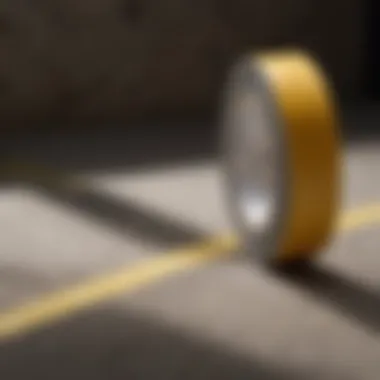

The interplay between temperature, weather resistance, and the application environment cannot be ignored. Mistakes in this area can lead to compromised results that are often frustrating to rectify.
Techniques for Effective Application
When it comes to using masking tape in concrete projects, employing the right techniques for application can mean the difference between a professional-looking finish and a less-than-ideal result. Proper application techniques can enhance not only the aesthetics of the project but also its durability. Mishaps stemming from poor tape placement can lead to uneven edges or paint bleed, costing time and materials. Hence, understanding these techniques is crucial for anyone looking to get the most out of their masking tape while working with concrete.
Surface Preparation
Before diving into any project, surface preparation is like setting the stage for a grand performance. If the surface isn't adequately cleaned or prepped, the tape won't adhere well, leading to complications down the road.
Start by ensuring the concrete surface is free of dust, grease, and moisture. It's akin to painting a wall; you wouldn't slap paint on a dirty surface and expect it to stick properly. A clean surface not only allows for better adhesion of the tape but also ensures that any subsequent layers, whether paint or stain, apply evenly without that annoying seepage you might get when the tape lifts.
Proper Placement Strategies
Ensuring the tape is placed correctly is half the battle won. Here, we'll break down strategies that are effective for straight lines and corners, as well as how to handle those pesky curved edges.
Straight Lines and Corners
Straight lines are often seen as the hallmark of any professional paint job, and masking tape can help achieve that sleek finish. The key characteristic of straight lines and corners is precision. It's a popular choice for anyone who desires clean, crisp transitions between different colors or textures. By securely placing the tape along the edges, you minimize the risk of paint bleeding, which can lead to a sloppy look.
One unique feature of using tape for these straight lines is its ability to create a sharp demarcation even on uneven surfaces. For example, if you're applying primer along a wall next to a concrete slab, well-placed tape can prevent accidents that might clash colors together. However, it's important to avoid placing the tape too far from the edge, as this can create unsightly gaps and make the project look rushed.
Curved Edges
Working with curved edges can certainly add a touch of finesse to any concrete project. The challenge here is that keeping tape straight can be a struggle. However, this is where specialty tapes shine because they can be adjusted to fit curves without leaving gaps. This flexibility is a fundamental characteristic that makes using masking tape for curves so beneficial in concrete projects.
The unique and handy feature for curves is often the ability of some tapes to adhere without folding or crumpling. When applied correctly, they will hug the contour of the surface, giving you a smooth finish that looks seamless. A drawback, however, is that one needs a bit more time to maneuver them, which may slow down the process.
Professional Tools for Application
To further enhance the application experience, employing professional tools can be a game changer. Tools like tape dispensers can ensure even tension while applying the tape, which is essential for maintaining the integrity of the edges. Additionally, using a smoothing tool can help press the tape down firmly and prevent any air bubbles that might cause misalignment. Key items to consider are:
- Tape dispensers for quicker application
- Smoothing tools for better adhesion
- Utility knives to create precise cuts when needed
In summary, incorporating these techniques makes the tedious job of applying masking tape not only efficient but also leads to results that reflect the care taken during the project. A little diligence here can pay off immensely in the final look of your concrete work.
Common Challenges with Masking Tape
Masking tape can be a handy ally in any concrete project, but it doesn't come without its share of headaches. Recognizing these common challenges is key for homeowners, DIY enthusiasts, and professionals alike. By understanding potential pitfalls, one can better prepare and adjust strategies when needed. Ultimately, this awareness leads to smoother applications and more satisfactory results.
Adhesive Residue Issues
Adhesive residue left behind after removal is arguably one of the most annoying challenges of using masking tape. Imagine putting in the hard work of painting or applying a concrete finish, only to find bits of sticky goo clinging stubbornly to your surface. This residue can be a real nuisance when it comes to achieving a clean final look, especially on concrete surfaces where aesthetics matter.
To combat this issue, it's paramount to select a tape that is specifically designed to minimize adhesive residue. For instance, some brands emphasize a low-tack adhesive that holds well during application but releases cleanly afterward. Moreover, proper removal techniques—lifting the tape back at a 45-degree angle rather than yanking it straight up—can go miles in reducing residue build-up. Taking the time to read labels will provide insight into how respective products may handle adhesive residue. Investing in quality tape often saves time in the end!
Tape Lift and Lapse
Another sticky wicket in the world of masking tape is tape lift and lapse. This phenomenon occurs when the tape’s edge gradually lifts off the surface, exposing areas that should have been covered and, in turn, ruining the desired crisp lines. Tape may lift for a few reasons: it could be the surface was not properly prepared, or the tape itself might not have enough adhesive strength for the job at hand.
For better adhesion, ensure that the surface is clean and dry before application. Additionally, using a tape suited for your specific project type will likely mitigate this issue. Some tapes are designed for rough surfaces whereas others work better on smooth finishes. Knowing your surface can lead you to the right choice. In circumstances where tape does start to lift, it’s worth checking the manufacturer’s guidelines regarding temperature and optimal use, as environmental conditions can also play a significant role.
Environmental Effects on Performance
Lastly, the environmental effects on performance of masking tape can dramatically influence its usability. Factors such as humidity, temperature, and even sunlight can alter the way tape adheres or performs during a project. For example, high humidity levels can compromise adhesive strength, leading to premature lifting or, conversely, making it difficult to achieve a neat removal of the tape later on.
Conversely, if the tape is applied in high temperatures, it may cure too quickly, causing poor adhesion and making a mess of your work. To tackle this, keep an eye on weather conditions when planning your concrete projects. If moisture levels or temperature predict a less-than-ideal day, consider postponing your work until conditions have improved.
"What a shame it is to spend hours crafting only to be waylaid by environmental factors!" Becoming attuned to these variables will help you navigate and adapt more effectively.
Safety Considerations
When working with masking tape in concrete projects, safety should always be at the forefront of your mind. It’s one thing to be excited about creating a beautiful finished product, but if you’re not careful, you could end up with more than just paint splatters. Proper safety practices can save you time, headaches, and possibly even some injuries. This section examines two main aspects: how to store your materials correctly and being aware of the chemical odors that may arise during the process.
Proper Storage Practices
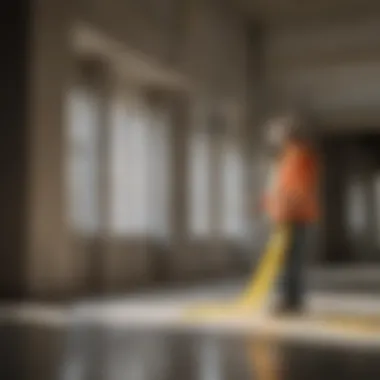

Storing masking tape might seem mundane, but there’s an art to it. Keeping your masking tape in a cool, dry place is essential. High humidity or extreme temperatures can warp the tape, rendering it less effective. Ideally, you want to store rolls upright, away from direct sunlight. A storage container works nicely—think of it as a little home for your tape.
Also, be mindful about how long you keep the tape around. Most masking tapes have a shelf life. Over time, the adhesive might lose its grip, leading you to struggle with tape that just won’t stick. It’s not just about preventing waste; actively checking your supplies allows for smoother projects down the line.
"A little attention to how you store your tools can save you a world of headaches when it comes time to use them."
Awareness of Chemical Odors
While working on your concrete projects, don’t overlook the smell that might come from the tape or the accompanying materials you use. Certain adhesives can release volatile organic compounds, or VOCs. While they might not be as noticeable, prolonged exposure to these chemicals can affect your health. It’s simple: if it smells off, it’s probably a good idea to do it in a well-ventilated space.
Next time you're rolling out that tape, take a moment to open windows or turn on a fan. This creates airflow, allowing any unpleasant odors to dissipate. Not only does this make for a more pleasant workspace, but it also aligns with a safer work environment, especially if kids or pets are around.
Overall, prioritizing safety, from proper storage to being aware of chemical releases, can make your concrete projects smoother and keep your living space healthy.
Best Practices for Maintenance
Maintaining handling and using masking tape in concrete projects is paramount. Not only does it help prolong the effectiveness of the tape, but it also ensures the quality of the work done. Without proper maintenance, all previous efforts can go to waste. By following best practices, you can ensure that masking tape performs optimally, enabling flawless results in your concrete work.
Regular Inspections
Carrying out regular inspections of masking tape is a good habit to cultivate. These checks are essential to ensure that the tape remains in good condition for future use.
- Inspect for Damage: Always look for tears, lifting edges, or any visible wear. A damaged piece of tape can compromise the entire masking job, leading to poor lines and potential touch-ups.
- Check Adhesive Quality: If the tape has lost its stickiness, it might not adhere well to the surface. Poor adhesion will allow paint or other materials to seep underneath, creating a mess that is hard to correct.
- Store Properly: Ensure that any unused tape is stored in a cool, dry place. Extreme heat or moisture can degrade the adhesive properties of the tape over time.
Regularly setting aside time to inspect your supplies can save you from headaches later on.
Cleaning Techniques
Cleaning the area where tape has been applied is as crucial as applying the tape itself. Knowing how to properly clean the residue left behind can make a world of difference in maintaining your work’s quality.
- Gentle Removal: When removing tape, do it slowly and steadily to avoid tearing it. Start from a corner and peel it back at a 45-degree angle.
- Use of Solvents: For stubborn adhesive residue on surfaces, gentle solvents like rubbing alcohol or adhesive removers can come in handy. Apply a small amount to a cloth and rub the area lightly until the residue is gone.
- Dry Cloth Wipe: Always finish by wiping down with a dry cloth to remove any excess solvent. This prevents any potential damage to the surface beneath.
- Test Before Full Application: If you’re using a new cleaning solution, do a small test patch first to ensure it does not damage the surface finish of your concrete.
Proper maintenance and cleaning of your masking tape not only prolongs its life but also guarantees a flawless finish in your concrete projects, proving that a little care goes a long way.
Future Trends in Masking Tape Technology
Keeping up with the progress in masking tape technology is crucial for professionals involved in concrete projects. It’s not just about sticking two surfaces — it’s about enhancing efficiency, achieving precise finishes, and ensuring that the final results stand the test of time. As we delve into the future trends of masking tape, we see innovations that cater to the evolving needs of both amateur and seasoned concrete artists.
Developments in Adhesive Materials
Advancements in adhesive materials are arguably at the forefront of masking tape innovation. Manufacturers are now harnessing technologies that allow for stronger and more versatile adhesives that bond effectively across various surfaces. For instance, next-generation adhesives not only provide superior holding power but also ensure easy removal without residue. This could mean less cleanup and increased productivity for those working on larger concrete projects.
Moreover, some newer adhesives are designed to be environmentally friendly, aligning with the growing trend towards sustainability. These materials, often made from natural or recycled components, reduce the overall environmental impact, making them ideal for conscious homeowners looking to complete their projects responsibly.
This revolution in adhesive technology might also open the doors to tapes that can withstand harsher conditions. Imagine taping out designs for outdoor concrete work where UV light and moisture are constant battles. Advanced adhesives are being developed to offer resistance against these elements, ensuring that your work remains intact.
Smart Masking Solutions
The rise of "smart" masking solutions transforms the way masking tape is utilized in concrete work. These products incorporate sensors or indicators that change color based on specific environmental conditions. Such adaptations can alert users when conditions are unfavorable for application or when it's safe to remove the tape without damaging the surface underneath. This level of feedback can significantly decrease the guesswork that often comes with concrete applications.
Furthermore, smart solutions can also offer functionalities like self-cutting mechanisms, allowing for more efficient use of the tape. Homeowners and professionals alike can appreciate a reduced waste scenario where precision cuts mean they get just the right amount without excess.
Adopting smart masking technology also speaks to an instinctively ingrained desire for connectivity in the DIY community. Tapes that can sync with smartphones or tablets can provide insights regarding application times, performance under various weather conditions, or even reminders for routine maintenance tasks.
"Innovation is what drives us to achieve greater results, and masking tape is no exception. Future developments promise not just efficiency but also empowerment for users keen on perfecting their concrete projects."
With these emerging trends, the landscape of masking tape in concrete work is set for transformation. As these technological advancements flourish, they will offer an array of options that not only simplify the tasks at hand but ultimately improve the quality and longevity of concrete applications.
Culmination
In summary, the role of masking tape in concrete projects cannot be overstated. This seemingly simple tool serves as a cornerstone for effective and efficient application, contributing to both the aesthetic and structural integrity of concrete work. From the initial stages of planning and preparation to the final touches, masking tape plays an integral role in achieving professional results.
Summary of Key Insights
Here are the primary takeaways highlighted throughout the article:
- Versatility: Masking tape comes in various types, tailored for specific tasks. Each type has distinct properties, making it crucial for achieving the desired effects in concrete applications.
- Adhesion Matters: The choice of masking tape can influence the outcome of a project significantly. From adhesive strength to environmental resilience, each characteristic needs careful consideration.
- Application Techniques: Successful application techniques, such as proper placement and using professional tools, can dramatically enhance the performance of masking tape and the overall project quality.
- Challenges and Solutions: Recognizing potential challenges like adhesive residue or tape lifting can save time and frustration. Proactive measures can minimize these issues and ensure a smooth execution.
- Safety and Maintenance: Understanding safe practices in storage as well as conducting regular inspections post-use reinforces the longevity and effectiveness of masking tape in projects.
Call for Experienced Use
For those more seasoned in their DIY endeavors or professional concrete applications, employing masking tape becomes second nature. However, even the experts must regularly reassess their methods and materials. Adapting to new masking tape options, understanding their evolving characteristics, and applying best practices can lead to more refined results. Your experience is invaluable; share your insights with others to help them navigate the nuances of masking tape. As masking tape technology advances, staying informed can make all the difference—not just enhancing your projects but also inspiring others to elevate their own concrete work.


